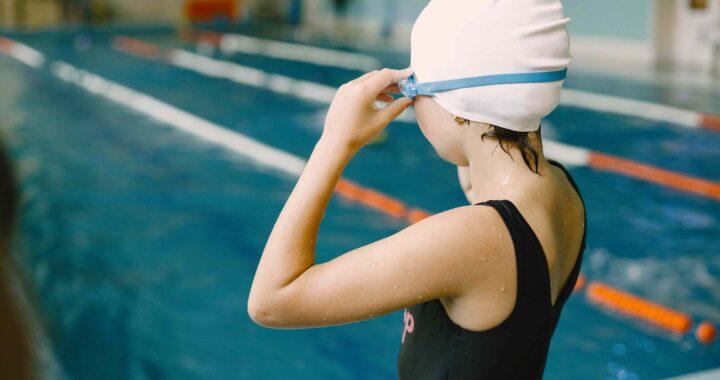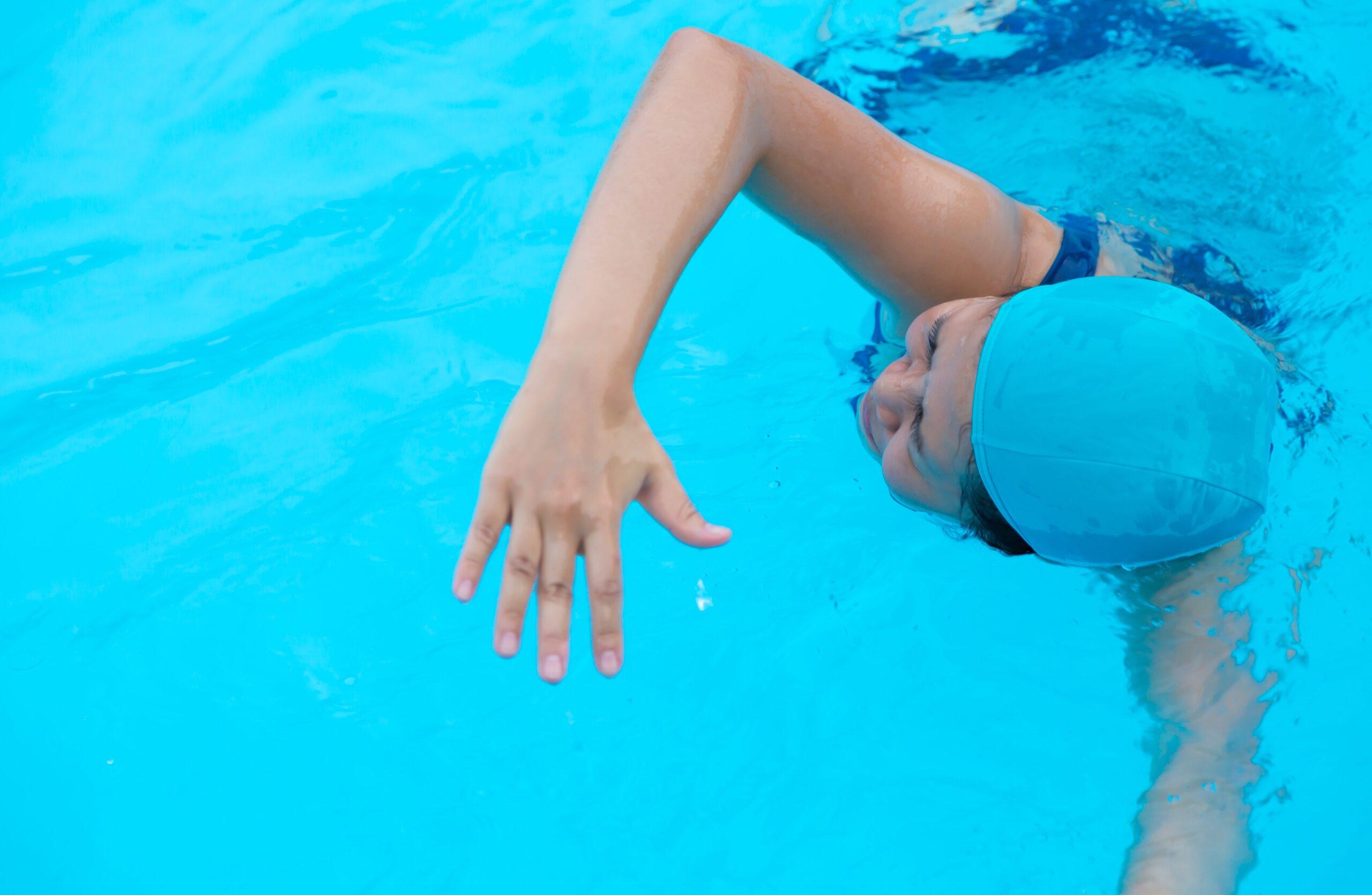Every confident swimmer starts by mastering the same foundational skills. To help you get started, we will cover the five basic skills every new swimmer should learn. These fundamental steps, including safe entry/exit, proper breathing, floating, kicking, and basic strokes, are the essential foundation for a successful and confident start to your aquatic journey.
1. Safe Ways to Get In and Out of the Water
Learning the proper ways to enter and exit the water helps prevent slips, falls, and other accidents, keeping you steady and comfortable every time you swim.
The Slide-In Entry
The slide-in entry is the safest method for any beginner. Sit on the pool deck, turn your body to face the wall, and slowly lower yourself in with your feet first. We recommend this approach over jumping because it prevents sudden cold shock and keeps you in control.
Using the Ladder
Always face the pool ladder when using it. It is best to maintain three points of contact at all times, such as two hands and one foot. Proceed slowly and deliberately.
The Wall Exit
Mastering the wall exit without a ladder is also a vital skill. Place both hands flat on the pool deck, about shoulder width apart. Use your arms to push your body up, and then swing one knee onto the edge. From there, you can easily climb out.
2. Proper Breathing Techniques
One of the biggest challenges for new swimmers is often breath control. Many instinctively hold their breath, which creates tension in the body. The key is to make breathing feel manageable and relaxed.
Basic Breathing Pattern
First, it is essential to practise the basic breathing pattern: breathe in through your mouth when your face is above the water and breathe out through your nose when it is beneath the surface.
Bubble Practice
A simple and effective way to get comfortable is to practise what we call "bubble practice". Hold onto the side of the pool, take a good breath through your mouth, then put your face in the water and gently hum or blow bubbles out of your nose. Exhaling in a controlled and steady way helps your body relax and builds immense confidence while swimming.
Rhythmic Breathing
Once you are at ease with bubble practice, this skill naturally evolves into rhythmic breathing. Rhythmic breathing means turning your head to the side for air, rather than lifting it straight up.
Lifting your head causes your hips to sink and uses a lot of energy, making it harder to move through the water. Learning a calm exhale is the true first step toward swimming with smooth, effortless strokes.
3. Floating Techniques
Learning to float is an integral part of feeling at ease in the water. This skill is all about trusting it to hold you up. Most importantly, always remember that everyone learns at a different pace, so take your time and breathe slowly!
Back Float
Start slowly by holding onto the pool wall. Gently start leaning your head back until your ears are submerged.
Take a full deep breath, relax and allow your hips and feet to lift naturally to the surface.
Relax completely and you will notice the water supporting your body eventually.
Quick Tip: If you feel that you’re starting to sink, take another breath and lift your chest slightly. Trust the water to do the work!
Front Float
To try a front float, hold onto the pool wall and take a deep breath.
Submerge your face into the water. Then, push off gently in the water with your arms and legs extended, allowing it to hold you up.
Quick Tip: Try practicing in shallow water at the start so you can stand up easily if you feel unsure. Every small step builds confidence.
It’s normal to feel a little wobbly when learning to float, the most important tip for swimming is to relax. Always keep in mind that a tense, rigid body will sink, but a relaxed one floats.
4. Kicking
Kicking provides the propulsion to move you through the pool. Learning the correct form for the flutter kick, which is used in freestyle, is vital for efficiency and preventing bad habits.
A common mistake we see in beginners of all ages, from toddlers to adults, is bending the knees too much, almost like pedalling a bicycle. This is often an instinct or a result of tension. Instead, your kicking power should originate from your hips, keeping your legs long and relatively straight.
Your ankles should also remain relaxed and flexible, with your toes pointed. Maintaining this flexible motion is how to swim basic flutter kicks properly.
A good way to practise is by holding onto the pool wall or a kickboard. Focus only on your leg movement, aiming for consistent ripples in the water, not large, energetic splashes, which can waste energy.
5. Basic Swimming Strokes
Once you are at ease with floating and kicking, you can begin coordinating your arm movements to learn basic strokes.
Developing proper strokes is a step-by-step process. That's why Isplash Swim School organises swimming classes for adults into three main stages, from beginner to advanced, allowing students to master new skills and progress confidently at their own pace.
Beginner Stage: Breaststroke and Freestyle
At the beginner level, students are introduced to their first swimming strokes, typically freestyle and breaststroke. Instructors use step-by-step progressions to build a strong foundation for a proper body position, effective kicking, and correct arm movements.
Intermediate Stage: Refining Strokes and Adding the Backstroke
At this stage, students work on refining their existing freestyle and breaststroke techniques. Lessons include correction drills to improve swimming efficiency, endurance, and coordination. This is also when students are introduced to a new technique, the backstroke.
Advanced Stage: Four Competitive Strokes
Advanced learners work toward mastering all four competitive strokes, including freestyle, backstroke, breaststroke, and butterfly. The emphasis is on enhancing technique, consistency, swimming speed, and endurance over greater distances.
Turn These Skills into Lifelong Confidence
While it is possible to learn on your own, the safest and fastest way to become truly at ease in the water is with a certified coach in a structured environment. Professional guidance helps you develop proper techniques from your first swimming lesson, allowing you to enjoy the full benefits of swimming, including better fitness and increased comfort in the water.
At Isplash Swim School, our certified instructors excel at creating this encouraging atmosphere. We ensure a more productive class by grouping students according to their proficiency, from our play-focused toddler swimming lessons to our structured swimming classes for adults.
Book your swimming lessons with us today!


